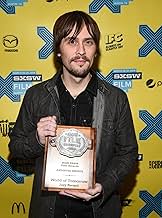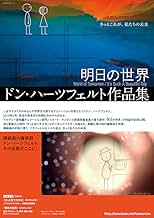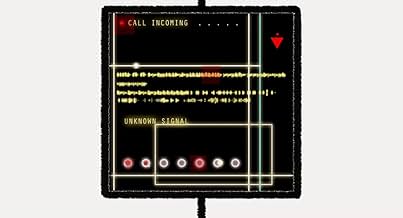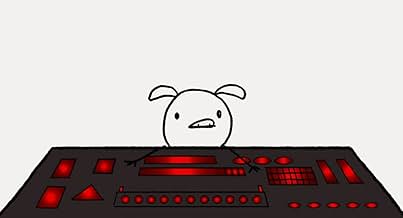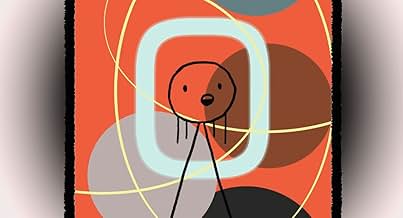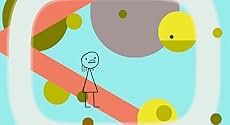IMDb-BEWERTUNG
8,1/10
10.779
IHRE BEWERTUNG
Füge eine Handlung in deiner Sprache hinzuA little girl is taken on a mind-bending tour of her distant future.A little girl is taken on a mind-bending tour of her distant future.A little girl is taken on a mind-bending tour of her distant future.
- Regie
- Drehbuch
- Hauptbesetzung
- Für 1 Oscar nominiert
- 27 Gewinne & 7 Nominierungen insgesamt
Julia Pott
- Emily
- (Synchronisation)
Winona Mae
- Emily Prime
- (Synchronisation)
Sara Cushman
- Simon
- (Synchronisation)
- (Nicht genannt)
Empfohlene Bewertungen
Don Hertzfeldt's seventeen-minute animated short World of Tomorrow, one of the Academy Awards' Best Animated Short frontrunners this year, does an amazing job of examining the flaw that most of us have as people and that's an inability to be satisfied or truly content with the present. We do not appreciate the present until it is the distant or the very-recent past, depending on how we deem the quality of our current situation. We look to the future as a relief or even a catalyst of the conditions we're currently facing, and we struggle to objectively define "self," especially in the age of the internet, where selves can be socially constructed or constructed in the lieu of the moment.
I realize I've proposed some lofty existentialist ideas with that first paragraph, but Hertzfeldt's beautifully detailed and immaculately animated short film effectively make your mind cycle through a whirlwind of feelings and thoughts about the human condition. The premise concerns a four-year-old girl named Emily Prime (voiced by Hertzfeldt's four-year-old niece Winona Mae, who was recorded while playing and drawing in order to generate natural dialog for the short), who has the typical wide-eyed wisdom and wonder that four-year-old girls have. Her days consist of playing with her precious cars, eating lunch, and wandering off to each adventure; her perceptions of happiness and sadness are heavily dichotomous and immediate. She is never both at the same time, and ostensibly never trying to avoid one or minimize another. Her moods are changing in the most obvious manner, but she's never one way for too long. She helps embody most of us in the way that we're occupied with life's trivialities and daily events.
One day, while playing with her cars, she's visited by an older Emily Prime (voiced by Julia Pott) via a transmission on a machine. This Emily is a third-generation clone broadcasting and communicating to Emily from two-hundred and twenty-seven years into the future. Older Emily explains to her younger, more idealistic self the cloning process, and how there are various methods for cloning; the wealthy can afford a safer process that permits time travel and such, successfully achieving immortality into adulthood, while the poorer members of society must settle for riskier cloning methods that could result in the very opposite - instant death.
This Emily takes her younger self on a journey through her life, which has seen her fall in love with rocks, robots, and eventually a fellow clone, who, because of his finances, had to settle for a less safe process. In addition, she walks younger Emily through a series of commonplace situations and features of the modern day, including a museum that houses a brainless human in a clear stasis tube where passersby observe him in a passive state while he grows older and withers before dying at 72.
In this futuristic utopia, memories are the most sacred part of the human experience, and increasing technological advances have allowed memories to be kept in small, black cubes in order to be stored for eternity - a process also afforded by society's most wealthy - or to be put on display in museums for humans to observe. These museums serve as the last piece of "real life" that humans can experience; most of the time, humans observe history, the day's events, and enjoy conversations with people through screens, severely limiting the idea of "reality."
World of Tomorrow accomplishes so much visually and thematically that it's stunning to note how short this film is, let alone how quickly it races past. Its ideas are dense and detailed, and its articulation so brisk and elaborate that it immediately warrants multiple viewings. At the heart of its depictions of technology and constant progress is a simple demand to all those living right now and that is "live." "You are the envy of the dead," Emily's clone states, with her echoing, monotone voice that has come with years of stagnant disillusionment and the inability to feel significantly. Often we cannot see the truth in that statement because, circumventing to what I said earlier, we are so caught up in the optimism and the aura of the future or the nostalgia for the past that we rarely observe what is occurring in the present.
Emily's clone states that day-to-day life's trivialities and benign occurrences are always irrelevant, and it's living which is the most sacred gift of all. The conception of reality, in addition, is another thing that has greatly been disturbed by internet (the world that Emily's clone shows her is called "the outernet," according to her). The ability to see and discern history through a few mouse-clicks and make far-away places seem closer have gone on to make what was closest to us more distant. Emily's clone shows this through her tired and dreary persona; she and her peers have been so accustomed to living life by finding multiple different channels and locations to pursue and attempting to be everywhere and do everything at once, that personal relationships, human connection, and love have all suffered as a result. The close becomes the distant and the distant becomes the immediately accessible.
World of Tomorrow's ideas are so expertly communicated that it's unfortunate how the genius animation and look behind it finds itself a secondary feature. The art design and illustration, all handled by Pott, as well, communicates a beautiful, harmonious relationship between the old, traditionalist style of animation coupled with the new, more experimental side that shows that 2D animation can still exercise immense creativity and visual possibilities on a totally different playing field than its counterpart. The result, coupled with dense themes and a true zest to define the world we're currently inhabiting, make World of Tomorrow such a masterwork of animation.
Voiced by: Julia Pott and Winona Mae. Directed by: Don Hertzfeldt.
I realize I've proposed some lofty existentialist ideas with that first paragraph, but Hertzfeldt's beautifully detailed and immaculately animated short film effectively make your mind cycle through a whirlwind of feelings and thoughts about the human condition. The premise concerns a four-year-old girl named Emily Prime (voiced by Hertzfeldt's four-year-old niece Winona Mae, who was recorded while playing and drawing in order to generate natural dialog for the short), who has the typical wide-eyed wisdom and wonder that four-year-old girls have. Her days consist of playing with her precious cars, eating lunch, and wandering off to each adventure; her perceptions of happiness and sadness are heavily dichotomous and immediate. She is never both at the same time, and ostensibly never trying to avoid one or minimize another. Her moods are changing in the most obvious manner, but she's never one way for too long. She helps embody most of us in the way that we're occupied with life's trivialities and daily events.
One day, while playing with her cars, she's visited by an older Emily Prime (voiced by Julia Pott) via a transmission on a machine. This Emily is a third-generation clone broadcasting and communicating to Emily from two-hundred and twenty-seven years into the future. Older Emily explains to her younger, more idealistic self the cloning process, and how there are various methods for cloning; the wealthy can afford a safer process that permits time travel and such, successfully achieving immortality into adulthood, while the poorer members of society must settle for riskier cloning methods that could result in the very opposite - instant death.
This Emily takes her younger self on a journey through her life, which has seen her fall in love with rocks, robots, and eventually a fellow clone, who, because of his finances, had to settle for a less safe process. In addition, she walks younger Emily through a series of commonplace situations and features of the modern day, including a museum that houses a brainless human in a clear stasis tube where passersby observe him in a passive state while he grows older and withers before dying at 72.
In this futuristic utopia, memories are the most sacred part of the human experience, and increasing technological advances have allowed memories to be kept in small, black cubes in order to be stored for eternity - a process also afforded by society's most wealthy - or to be put on display in museums for humans to observe. These museums serve as the last piece of "real life" that humans can experience; most of the time, humans observe history, the day's events, and enjoy conversations with people through screens, severely limiting the idea of "reality."
World of Tomorrow accomplishes so much visually and thematically that it's stunning to note how short this film is, let alone how quickly it races past. Its ideas are dense and detailed, and its articulation so brisk and elaborate that it immediately warrants multiple viewings. At the heart of its depictions of technology and constant progress is a simple demand to all those living right now and that is "live." "You are the envy of the dead," Emily's clone states, with her echoing, monotone voice that has come with years of stagnant disillusionment and the inability to feel significantly. Often we cannot see the truth in that statement because, circumventing to what I said earlier, we are so caught up in the optimism and the aura of the future or the nostalgia for the past that we rarely observe what is occurring in the present.
Emily's clone states that day-to-day life's trivialities and benign occurrences are always irrelevant, and it's living which is the most sacred gift of all. The conception of reality, in addition, is another thing that has greatly been disturbed by internet (the world that Emily's clone shows her is called "the outernet," according to her). The ability to see and discern history through a few mouse-clicks and make far-away places seem closer have gone on to make what was closest to us more distant. Emily's clone shows this through her tired and dreary persona; she and her peers have been so accustomed to living life by finding multiple different channels and locations to pursue and attempting to be everywhere and do everything at once, that personal relationships, human connection, and love have all suffered as a result. The close becomes the distant and the distant becomes the immediately accessible.
World of Tomorrow's ideas are so expertly communicated that it's unfortunate how the genius animation and look behind it finds itself a secondary feature. The art design and illustration, all handled by Pott, as well, communicates a beautiful, harmonious relationship between the old, traditionalist style of animation coupled with the new, more experimental side that shows that 2D animation can still exercise immense creativity and visual possibilities on a totally different playing field than its counterpart. The result, coupled with dense themes and a true zest to define the world we're currently inhabiting, make World of Tomorrow such a masterwork of animation.
Voiced by: Julia Pott and Winona Mae. Directed by: Don Hertzfeldt.
I know it may be strange to do a full length review on a short film, but I felt this one deserved it. Don Hertzfeldt is one of my favorite animators right now and he's done other work that I loved like "It's Such A Beautiful Day" (which I will review at some point in the future) and the disturbingly funny "Rejected". "World Of Tomorrow" is his most recent work, and probably his most critically praised. What do I think of it? I think its absolutely fantastic. Personally, I don't think its as good as "It's Such A Beautiful Day", but still great. Anyways lets continue.
One thing to note is the animation. Hertzfeldt is known for using a somewhat minimalistic but unique style for most of his work, and this is probably his most visual work, since it presents other planets and parts of space. It does use a lot of techniques to create this style like using live action, special blur effects and so on. The short also has an amazingly creative and original story, so creative that it kinda reminds me of those famous short stories from Phillip K. Dick. It does bring up these great concepts, but also has time for emotional and funny moments. There is also some nice voice acting with the clone of Emily and her younger self.
So in the end "World Of Tomorrow" is a creative, funny, and touching animation that makes you think long after you have viewed it. Honestly guys, go watch it now, its on Netflix its only 15 minutes long and I promise you that you won't regret it.
Final Score: 8.5/10
One thing to note is the animation. Hertzfeldt is known for using a somewhat minimalistic but unique style for most of his work, and this is probably his most visual work, since it presents other planets and parts of space. It does use a lot of techniques to create this style like using live action, special blur effects and so on. The short also has an amazingly creative and original story, so creative that it kinda reminds me of those famous short stories from Phillip K. Dick. It does bring up these great concepts, but also has time for emotional and funny moments. There is also some nice voice acting with the clone of Emily and her younger self.
So in the end "World Of Tomorrow" is a creative, funny, and touching animation that makes you think long after you have viewed it. Honestly guys, go watch it now, its on Netflix its only 15 minutes long and I promise you that you won't regret it.
Final Score: 8.5/10
Young child Emily is contacted by the third generation clone of herself from 220 years into the future. This Emily brings child Emily into the future and shows her the world that she will soon live in.
I have read quite a few user comments here that attempt to sum up all the themes and ideas within this short film, and mostly I think they both do it well but also do the film a huge disservice by so crudely laying it out with their words. The film plays out with a great sense of humor combined with angst, despair, beauty, hope, and death. The flat emotional tone of future Emily makes this mix work very well, and the contrast with the simple child Emily also adds to the emotional core of the piece. And this core does exist, although you would think it would struggle under so many darker ideas and themes.
The animation is at once simplistic (the Emilys are stick figures) but yet fantastic in the creativity of the world in which it occurs; everything is pretty minimalist in design but yet there is plenty of detail that makes it visually engaging and quite wonderful to watch. It is the dark gallows humor that sticks with me though, in particular the way that it is used to deliver a message about what is important in life. This short has been very successful and is very well known, so it doesn't need me to say much about it – but it is a great piece of work that is well worth seeing for how creative, intelligent, funny, moving, and entertaining it is.
I have read quite a few user comments here that attempt to sum up all the themes and ideas within this short film, and mostly I think they both do it well but also do the film a huge disservice by so crudely laying it out with their words. The film plays out with a great sense of humor combined with angst, despair, beauty, hope, and death. The flat emotional tone of future Emily makes this mix work very well, and the contrast with the simple child Emily also adds to the emotional core of the piece. And this core does exist, although you would think it would struggle under so many darker ideas and themes.
The animation is at once simplistic (the Emilys are stick figures) but yet fantastic in the creativity of the world in which it occurs; everything is pretty minimalist in design but yet there is plenty of detail that makes it visually engaging and quite wonderful to watch. It is the dark gallows humor that sticks with me though, in particular the way that it is used to deliver a message about what is important in life. This short has been very successful and is very well known, so it doesn't need me to say much about it – but it is a great piece of work that is well worth seeing for how creative, intelligent, funny, moving, and entertaining it is.
If you were to watch Don Hertzfeldt's very funny and still wildly outrageous short Rejected from 2000 and go to his latest film, World of Tomorrow, you would see a monumental level of growth as a filmmaker. This isn't to say that he's moved on from having crudely-drawn characters (by design, and delightfully so as absurdly cute, absurdist what-the-f*** things), and that's part of his style. But if you go from one to another there's a level of sophistication to the presentation that has developed. This also isn't to say that Rejected isn't genius on its own level, but watching World of Tomorrow is simply mind-blowing, shot to shot, and that it presents science fiction concepts with such a dead-pan expression emotionally (the voice of the older 'clone' of Emily is just this way) while expressing such seemingly limitless imagination.
We're basically taken, from one older adult clone to her much younger counterpart from the past, into what the future will hold. There's (messy) time travel, there's the 'art' of gathering up old memories that drift along like paintings that can be put on the walls, and there's things like people being put into glass containers to be watched by people like in an exhibit throughout their lives. Oh, and there's not the internet but the OUTER-net, where people just drift along through the neural-connections and some, indeed, become lost.
This is extremely, massively heady stuff, but because of the context of it being between a little girl with notions like "I had lunch today" and "wiggle wiggle wiggle", and that this older clone has gone through a life of her own but with the sort of self-reflection that is very sad, we can relate to it. Or, at least, I could, and it just hit me on a profound level that is hard to describe after one viewing. Information is given out quickly, but nothing is too confusing if one is tapped into its peculiar, visionary science fiction head-space - there's even at one point a poem read by the older Emily about what it means to be a robot (a 'bad' poem, which is acknowledged).
The level of humor is still there for Hertzfeldt that one sees in Rejected or his Third Dimension shorts or any given work he's done. But something about World of Tomorrow is even more striking than his other work, and it may have to do with how he goes from one concept to the next, each shot and set piece with equal parts crazy veracity and almost simplistic grandeur (those shots of the "rich" people of the future uploading their consciousnesses as black boxes going out into space). This mix of incredibly complex and incredibly simple strikes the perfect balance and yet for the seemingly ridiculous angle of how the older Emily interacts with the younger Emily there's an immediate emotional bond, and even an ending that is incredibly emotional.
All I can say is if you have netflix, or a few bucks to spare on Vimeo, watch it and see if it affects you. For me, it's among the greatest short films ever made.
We're basically taken, from one older adult clone to her much younger counterpart from the past, into what the future will hold. There's (messy) time travel, there's the 'art' of gathering up old memories that drift along like paintings that can be put on the walls, and there's things like people being put into glass containers to be watched by people like in an exhibit throughout their lives. Oh, and there's not the internet but the OUTER-net, where people just drift along through the neural-connections and some, indeed, become lost.
This is extremely, massively heady stuff, but because of the context of it being between a little girl with notions like "I had lunch today" and "wiggle wiggle wiggle", and that this older clone has gone through a life of her own but with the sort of self-reflection that is very sad, we can relate to it. Or, at least, I could, and it just hit me on a profound level that is hard to describe after one viewing. Information is given out quickly, but nothing is too confusing if one is tapped into its peculiar, visionary science fiction head-space - there's even at one point a poem read by the older Emily about what it means to be a robot (a 'bad' poem, which is acknowledged).
The level of humor is still there for Hertzfeldt that one sees in Rejected or his Third Dimension shorts or any given work he's done. But something about World of Tomorrow is even more striking than his other work, and it may have to do with how he goes from one concept to the next, each shot and set piece with equal parts crazy veracity and almost simplistic grandeur (those shots of the "rich" people of the future uploading their consciousnesses as black boxes going out into space). This mix of incredibly complex and incredibly simple strikes the perfect balance and yet for the seemingly ridiculous angle of how the older Emily interacts with the younger Emily there's an immediate emotional bond, and even an ending that is incredibly emotional.
All I can say is if you have netflix, or a few bucks to spare on Vimeo, watch it and see if it affects you. For me, it's among the greatest short films ever made.
World of Tomorrow (2015)
*** 1/2 (out of 4)
Don Hertzfeldt's rather unique and original animated short deals with a young girl who is visited from the future by her third clone, which takes her into the future and show her how the world has changed in the two hundred plus years.
I'm watching this short a couple days before the Oscars are actually announced and I must admit that I'll be shocked if something beats this. Well, it's the Oscars so I guess anything is possible but this is a rather clever, original and unique little gem that manages to be rather smart throughout its 17 minute running time. The animation itself is rather laid back but I thought this approach actually worked extremely well and especially when you consider that it's the screenplay and story that is really selling the material. Both Julia Pott and Winona Mae are extremely effective with their voices and really sell the characters quite nicely.
*** 1/2 (out of 4)
Don Hertzfeldt's rather unique and original animated short deals with a young girl who is visited from the future by her third clone, which takes her into the future and show her how the world has changed in the two hundred plus years.
I'm watching this short a couple days before the Oscars are actually announced and I must admit that I'll be shocked if something beats this. Well, it's the Oscars so I guess anything is possible but this is a rather clever, original and unique little gem that manages to be rather smart throughout its 17 minute running time. The animation itself is rather laid back but I thought this approach actually worked extremely well and especially when you consider that it's the screenplay and story that is really selling the material. Both Julia Pott and Winona Mae are extremely effective with their voices and really sell the characters quite nicely.
Wusstest du schon
- WissenswertesDon Hertzfeldt's first digitally animated film. All of his other films were shot on 16mm and 35mm, but he animated this film using a Cintiq tablet, Photoshop and Final Cut Pro. He stated in an interview that he did this because that since the film takes place in the future and that the future looks so abstract, it would be impossible and time consuming to do it right on film.
- PatzerThe moon always presents the same face to the Earth and orbits the earth once every 28 days, which means the robots escaping the darkness are circling the moon at that same rate. The "dark side of the moon" is called that only because that is the face which is not visible from Earth, not because it is always in darkness.
- VerbindungenEdited from The 17th Annual Animation Show of Shows (2015)
- SoundtracksDer Rosenkavalier: Waltz Suite
Composed by Richard Strauss
Top-Auswahl
Melde dich zum Bewerten an und greife auf die Watchlist für personalisierte Empfehlungen zu.
Details
- Laufzeit17 Minuten
- Farbe
- Seitenverhältnis
- 1.78 : 1
Zu dieser Seite beitragen
Bearbeitung vorschlagen oder fehlenden Inhalt hinzufügen


